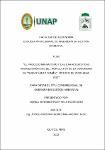El proceso migratorio y las características socioeconómicas del agricultor de la comunidad de “Nuevo Santo Tomás”. Distrito de Punchana. 2021
Abstract
The research carried out in the Native community of Nuevo Santo Tomás, Nanay river, consisted of evaluating the socioeconomic characteristics of the farmer and the migratory process in the year 2021. The study objectives were: to characterize and determine the socioeconomic characteristics that condition the migratory process in the community of "Nuevo Santo Tomas" district of Punchana. 2021. The non-experimental, quantitative research design was used. The research work is descriptive-transversal. A simple probabilistic sample was used, where 40 people who live in the study community and have Kukama kukamilla ethnic ancestry were chosen. The results achieved were developed through descriptive statistics and were as follows: the age range of 31 to 45 years (30%), 16 to 30 years (25%) and over 61 years (27.5%) prevails, and They have some level or degree of education, such as primary (56%), secondary (42.5%) and higher technical (3%). For the migratory process, the preference of this choice is mostly young people (65%) and adults (25%), this attitude predominating in men (65%), migration is not planned (70%); Once the migration is over, they choose to stay in areas close to their homeland (62.5%). Regarding land tenure, this community is considered native and communal property prevails (100%), they plant mostly up to 1 hectare (61.11%), 2 hectares (27.78%) and more than 3 hectares (11.11%), where they cultivate species Priority crops such as cassava, plantain, corn and sugar cane, combined with fruit trees: açaí, caimito, anona, pijuayo, guabas, citrus, among others. La investigación realizada en la comunidad Nativa de Nuevo Santo Tomás, rio Nanay, consistió en evaluar las características socioeconómicas del agricultor y el proceso migratorio en el año 2021. Los objetivos de estudio fueron: caracterizar y determinar las características socioeconómicas que condicionan el proceso migratorio en la comunidad de “Nuevo Santo Tomas” distrito de Punchana. 2021.Se utilizó el diseño de investigación no experimental, cuantitativa El trabajo de investigación es descriptivo-transversal. Se manejo una muestra probabilística simple, donde se escogió 40 personas que viven en la comunidad del estudio y tienen ascendencia étnica Kukama kukamilla. Los resultados logrados se desarrollaron a través de la estadística descriptiva y fueron lo siguiente: prevalece el rango de edades de 31 a 45 años (30%), 16 a 30 años (25%) y mayores a 61 años (27.5%), y cuentan con algún nivel o grado de instrucción, como primaria (56%), secundaría (42.5%) y superior técnica (3%). Para el proceso migratorio la preferencia de esta elección, lo tienen los jóvenes en su mayoría (65%) y adultos (25%), predominando esta actitud en los varones (65%), la migración no es planificada (70%); hecha la migración optan por quedarse en zonas cercanas a su terruño (62.5%). Sobre la tenencia de tierras, esta comunidad es considerada nativa y prevalece la propiedad comunal (100%), siembran mayormente hasta 1 hectárea (61.11%), 2 hectáreas (27.78%) y mayor a 3 hectáreas (11.11%), donde cultivan especies prioritarias como yuca, plátano, maíz y caña de azúcar, combinados con frutales: asaí, caimito, anona, pijuayo, guabas, cítricos, entre otros.
Collections
- Tesis [501]


